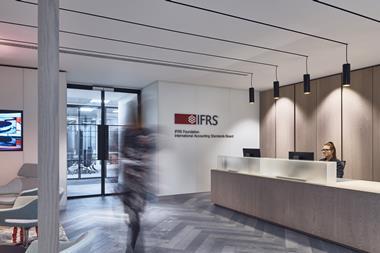As increasing numbers of institutions commit assets to socially responsible investments (SRI), debates on the strength of the business case continue.
Can screening out certain companies damage a pension fund’s wealth? Or does stock selection on a best-in-class basis guarantee good returns?
A recent report by Commerzbank Securities, entitled ‘Green with Envy’, suggests investors that favour socially responsible investments face additional and more complex risks than conventional investors.
According to the report, investment styles and themes themselves contribute only two-thirds of the risk to SRI investments, while only one-third comes from stock-specific effects. This implies that SRI portfolios will have a different long-term risk expectation, and therefore return expectation, than conventional portfolios. The report also said that pre-specified risk models do not form a useful base for managing SRI portfolios.
John Marsland, head of portfolio and risk advisory team at Commerzbank Securities, says: “SRI is a very fast-growing area, there are a number of well-known managers who run successful ethical portfolios, both active and passive. But what is not widely appreciated in the market place, is the magnitude of risk you take against the normal benchmark portfolio by running an ethical portfolio.”
He adds: “We see risk and return as being two sides of the same coin. In order to justify the risk you have taken, you have to get incremental performance above and beyond wider European benchmarks. It is not sufficient for an SRI portfolio to merely perform in line with that benchmark.”
As fund managers’ risk forecasting horizons tend to be very short-term, around a quarter to a year, the Commerzbank report argues that longer-term sustainable developments are difficult to justify.
However, proponents of SRI disagree. Alan Banks, chief executive officer of Global Risk Management, an independent SRI research house, says: “Some sectors in the investible universe are SRI-unfriendly – arms, tobacco, mining and extractive industries – SRI funds will either not hold these shares or relatively less of them and therefore have a natural bias towards service sector and high technology companies. Therefore their portfolios are skewed. I don’t believe this is a riskier portfolio, but I do agree that it is a portfolio which diverges from the standard makeup of an index.”
It is argued that SRI investing is equivalent to style investing, using the same principles of active investment, where some shares in the investible universe are held and not others, selected according certain criteria.
Banks says: “SRI is a style choice, in the same way that growth investing is a style choice. Instead of selecting companies on the basis of being small, high yield, high growth, high tech or small tech – we are selecting them on the basis that they are ethical, there is no difference at all in terms of process.”
SRI has moved on from negative exclusionary screening activities and has opted for a best-in-class approach – for example, investing in oil companies such as BP and Shell who are striving to be ‘clean and green’.
Neil Marsh, European managing director at Innovest Strategic Value Advisors, an investment company specialising in research of intangibles including social, environmental and governance issues, says: “The problem with the Commerzbank report is that it doesn’t really address what sustainability and SRI is these days. It is addressed as a historic screening approach but I think SRI is more than that. Investment managers are looking in greater detail than simply screening out stocks.”
Banks agrees: “The majority of the SRI industry tends to adopt the best-in-class approach whereby they invest in and analyse all sectors, reward the good companies by investing in relatively more of them and punish the bad companies by investing less. They then actively engage with those companies in their portfolios to improve performance on SRI issues, thereby exercising their shareholder responsibilities.”
The Commerzbank report also points to the relatively higher risks of SRI benchmarks in comparison to actively managed institutional portfolios. It states that the expected tracking error of a passive SRI benchmark fund is higher than many institutions would be comfortable with. Risk arising from funds management would be additional.
It focuses on the FTSE4Good and Dow Jones Sustainability Indexes, comparing the FTSE4Good Europe against the standard FTSE Europe benchmark. It analyses basic risk characteristics, country exposure decomposition, sector exposure decomposition, theme and style exposure and individual stock exposure decomposition.
Tracking error was found to be relatively high, at 2.58%, in comparison to many actively managed institutional portfolios.
Marsland says: “Fund managers could either benchmark against a specialist index such as the FTSE4Good or a standard mainstream index. The gap between those two types of benchmarks illustrates the median SRI portfolio. If you are an active investor in SRI portfolios, your starting point is the risk that you take in an SRI benchmark, and you add to that risk by deciding which of companies you should include or exclude.”
Alex Barkawi of Dow Jones Sustainability Indexes says: “With every industry exclusion you make, you increase your tracking error and this is an important argument in favour of positive screening instead of deleting whole industries from your portfolio.”
But he disagrees with the report’s suggestion of a higher level of risk associated with SRI investments. “I think it is higher compared to passive investment based on the index, but not necessarily higher compared to any active management based on that index. There is active management with significantly higher tracking errors than 2.58%, and talk of enhanced indexing with similar tracking errors.”
Although sustainability indices, such as the ones the report focuses on, serve to increase mainstream awareness of SRI issues, most of them are criticised for their lack of transparency, weak ethical bias and high tracking errors. Many mainstream investment managers involved in SRI prefer to benchmark against traditional or standard indices.
One of the criticisms is that, although these indices boast impressive numbers of listed companies, these include many that simply aspire to be in the index rather than address issues of sustainability effectively.
Banks says: “My concern with these indices is that there is no relativity between the companies and limited transparency as to how they got in. We know what the criteria are but we don’t know what they actually did to get in. There is very little independent verification of company performance. It is very much questionnaire-based, so to a large extent, it is a self-assessment exercise by the companies.”
The Myners report also states that trustees should be aware of the methodology with which indexes are constructed, as this will have an impact on their portfolios. When choosing a sustainability index, trustees need to know how the index has been constructed, in order to ensure they have a certain sector allocation and diversification across countries.
Marsland says: “It is possible to design portfolios that have risk characteristics, which are simpler than traditional portfolios, but using the same sustainable and SRI screened companies.”
Index providers need to ensure that mainstream investors, who may not want to deviate too much from sector allocations of mainstream markets, can track their indexes.
Barkawi says: “The report refers to different sectors contributing to risk and state that two-thirds of risk comes from factor other than stock selection itself. This is where as an index provider you need to make sure in your construction rules that you comes as close as possible to traditional index characteristics. We make sure that our sector allocation is very close to that of the Dow Jones Global Index.”
In the case of the FTSE4Good index, companies that meet the criteria within the given threshold are included, regardless of how many of them have already been included and of what their market cap coverage already is. As a result, some industries will have a higher proportion that meets the threshold and others with a lower proportion. Increased possibilities of over and under allocation in terms of sectors when compared to the traditional indexes, is attributed to this factor.
The index currently applies three sets of criteria that companies must meet in order to qualify for the index series – human rights, stakeholder relations and environmental sustainability. Companies involved in tobacco or weapon manufacturing and nuclear power are excluded from the onset.
Paul Grimes, chief financial officer, FTSE, says: “The reasons those exclusions are in place are because there are common themes or sectors which do not sit comfortably with SRI practitioners.”
He argues that the issue of tracking error identified in the Commerzbank report needs to be put in context. “They are not comparing apples with apples. FTSE4Good is a new benchmark, so you can’t compare that selective benchmark against a more general one, because there is bound to be a difference.
By taking a subset of the FTSE4good Europe such as the FTSE4Good 50, you are then comparing the top 50 stocks within that FTSE4Good benchmark. This will give a better comparison as they share the same characteristics.”
FTSE are currently reviewing their methodology and are in the process of introducing new criteria. Grimes says: “Both exclusions and criteria are subject to improvement.”
While most industry practitioners welcome the Commerzbank report as an opportunity to further create awareness of SRI investing, it has also been criticised for merely scratching the surface and analysing a snapshot of this industry, one of negative screens, whereas the SRI market has long since moved on to a best-in-class and engagement approach.
The issue of sustainability indexes remains a contentious one and the general consensus seems to be that while they continue to promote sustainable investments, they could also be detrimental by not providing sufficient transparency so that companies are forced to address social, environmental and sustainable issues more effectively.
Perhaps they will need to increase their thresholds, in order to ensure that companies included in the index are truly best performing in terms of sustainability criteria.
Marsh concludes: “By carrying out positive research that identifies strong areas of performance and potential risk, then one has added information which adds to the ability to select stocks. In this manner, you will reduce risk and ultimately create higher returns.”












No comments yet